Sedation dentistry keeps you comfortable during dental procedures. It’s beneficial for people with dental anxiety or for those who are undergoing lengthy treatment. Options include nitrous oxide, oral conscious sedation and intravenous (IV) sedation
Types of Sedation Dentistry
Oral Sedation
Oral sedation, also called “conscious sedation,” involves you taking a prescribed dose of sedative before your procedure. Depending on your case, you may take one pill the night before, and one pill an hour before you have the procedure, or otherwise as directed by your dentist or doctor. This type of sedation leaves you awake for the procedure, but significantly relaxes you. Patients who have higher levels of anxiety often benefit from this type of dentistry.
Though you’re awake during your procedure, most patients remember either very little or nothing at all of the appointment after it’s happened. Depending on your case, while you’re under oral sedation, you may be hooked up to equipment that monitors your heart rate, blood pressure, and breathing, or you may not require that kind of monitoring. It depends on factors which your dentist will determine. The sedative will leave you feeling sleepy, but by the next day all the effects will have worn off. You’ll need a ride home from the dentist, though, so plan with a friend or family member in advance.
IV Sedation
IV sedation has a few variations: the first is what’s known as “twilight,” where you’re conscious, but not very aware of your surroundings. Twilight IV sedation makes you feel sleepy, and you may not remember any of the procedure once it’s over. However, you are not unconscious, and if the dentist needs to wake you up, it’s possible.
The other option is general anesthesia, which is relatively uncommon as far as sleep dentistry goes. Only patients who need significant oral surgery, or who are resistant to other types of sedation, will need general anesthesia. With general anesthesia, you’re totally unconscious. This kind of sedation needs to happen in a hospital or a specialized clinic with either a nurse anesthetist or an anesthesiologist administering the sedative and monitoring your vital signs
